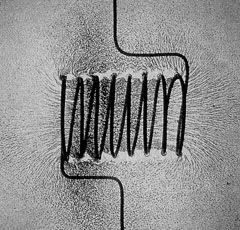Home > Science > Concepts of Physics 101 > Electricity and Electromagnetism
Electricity and Electromagnetism
There is a very strong connection between electricity and magnetism. As early as 1820, Danish physicist and chemist Hans Christian Oersted demonstrated that the flow of an electric current in a wire created a magnetic field around the wire. A dozen years later, English chemist Michael Faraday in turn demonstrated that moving a magnet along a wire generated an electric current in the wire. These two historic discoveries showed that electricity and magnetism are two sides of the same coin. The discoveries during this era also paved the way for a multitude of then unimaginable applications.
People have known about magnetism for a very long time. It is a physical phenomenon that manifests itself through attraction or repulsion occurring at certain distances between objects. These forces can align the needle of a compass or even lift metal objects. Magnetic fields can be produced by natural or synthetic magnets, but also by electromagnets composed of a coil wound around a soft iron or steel core through which a current flows.
All natural synthetic and electric magnets have a north and a south pole. They attract and repulse, depending on their differences or similarities. The lines of a magnetic field are always parallel and travel from the north to the south pole outside the magnet and from the south to the north pole inside the magnet. The intensity of a magnetic field decreased quickly with distance.
As its name indicates, the phenomenon of electricity is linked to electrons, miniscule electrically charged particles in orbit around the nuclei of all atoms found in the physical world. Negatively charged electrons are attracted to positively charged protons in the nucleus of the atom. However, electrons in more distant orbits are attracted more weakly. Under the effect of a magnetic or electrical field, these electrons can be drawn from their respective orbits to move freely between the atoms and form a more or less strong electric current.
Electromagnetic phenomena play a fundamental role in the constitution of all matter found in our world and in the natural phenomena around us. A better understanding of these phenomena led to the development of the first pieces of electrical equipment such as generators, transformers and motors. Today, these same electromagnetic phenomena are applied to increasing numbers of innovative electronic, telecommunication and computer devices.







